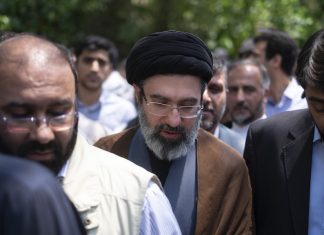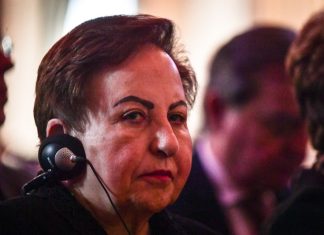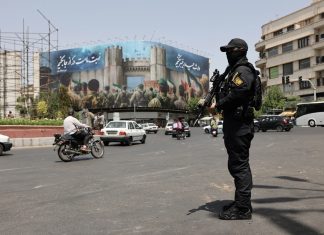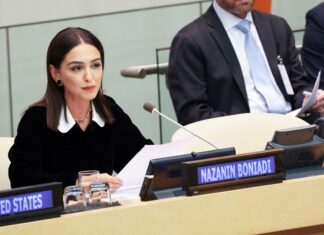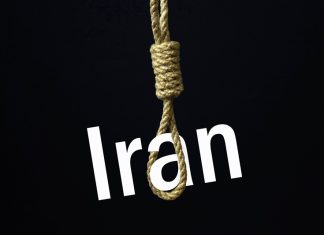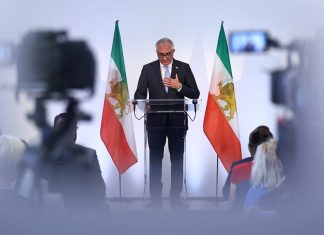Prisoner assaults and the use of torture in detention centers are now commonplace within Iran’s justice system, according to Professor Mahmood Amiry-Moghaddam, the founder of Oslo-based NGO Iran Human Rights (IHR) which focuses on the death penalty.
Surveillance footage leaked on Twitter this week by the Iranian hacker group Tapandegan shows guards repeatedly assaulting a prisoner inside Iran’s Evin prison. A separate clip shows an older prisoner being dragged across the floor by a prison guard after fainting from hunger while other officials and a cleric walked past.
Tech experts who verified the footage said the videos showed that the prison’s computer systems were using Microsoft Windows 7, which no longer receives updates, making it vulnerable to attack. Additional footage appeared to show the word “cyberattack” flashing onto a computer screen alongside a picture of scales. The image was then replaced with the message: “The Evin prison is a stain on Raisi’s black turban and white beard.”
The leak prompted the head of Iran’s prison service Mohammad Mehdi Haj-Mohammadi to apologize on Aug. 24 for the assaults and say that he took responsibility for the “unacceptable behavior.”
Speaking to Kayhan Life, Professor Amiry-Moghaddam said: “When we see video footage like this, we understand why the Iranian government denies [independent bodies] entry to such places. This lack of respect for other human beings shows that the inhumane treatment of prisoners has become institutionalized in Iran. Despite knowing that there are cameras around, officials still behave this way.”
“IHR has read and heard witness testimonies which are far worse than what we’ve seen in these videos, which have been taken from communal areas of the prison. We can’t even imagine what is going on behind closed doors in the interrogation rooms of Ward 209 and Ward 2A. These wards are under the control of the Ministry of Intelligence and the Revolutionary Guards. Most of the reports of torture are from those wards,” Amiry-Moghaddam added.
Iranians are using #SaveHaydarGhorbani to protest the imminent execution of the Kurdish political prisoner in Sanandaj Central Prison. Denied a fair trial, due process and subjected to torture, his family were told on Aug 11 that his death sentence was sent for execution #Iran https://t.co/re9mYWetlM
— Iran Human Rights (IHR) (@IHRights) August 22, 2021
A July 16 report by the United Nations special rapporteur on human rights in the Islamic Republic of Iran, Javaid Rehman, condemned the Iranian government for poor conditions inside the country’s prisons. The report highlighted several human rights concerns including: abuse of the death penalty; child executions; human rights violations during the 2021 presidential election; a lack of accountability in government; the impact of economic mismanagement on the population; discrimination against women and minority groups; and the ongoing suppression of freedom of expression by Iran’s government.
Rehman said he “continued to be disturbed by the high number of death sentences and executions in the Islamic Republic of Iran,” as well as by “fair trial issues, including the use of torture-induced confessions [rendered] most if not all executions in the state an arbitrary deprivation of life.”
SPECIAL REPORT- Iran’s Leader Ordered Crackdown on Unrest: “Do Whatever It Takes to End It”
Iran is the second most active country after China for its use of the death penalty. According to a report published on March 30 by IHR, the Iranian government executed at least 267 prisoners in 2020. IHR added that 89 of the 117 executions which took place in the first 6 months of 2021 were carried out in secret. Further research published on IHR’s website estimated that at least 6,255 executions had been carried out in Iran since 2010, including 160 executions of women and the execution of 64 children.
The UN Committee on the Rights of the Child — of which Rehman is a member — raised concerns about Iran’s execution of child offenders in a June 24 statement, urging Iran to end the practice. The committee said that at least four children were executed in 2020 and that to date more than 85 children were on death row.
In two separate cases, two defendants in #Tehran were sentenced to death by the 2nd and 7th Branches of the 1st Criminal Court of Tehran respectively. #Iran ranks 1st in the world in citizen executions per capita, according to international organizations.https://t.co/mNFynT0jJQ pic.twitter.com/y6RMvkgMIK — HRANA English (@HRANA_English) August 23, 2021
The special rapporteur said he was equally concerned by “reported attempts by the authorities to continue to destroy evidence of past violations, including the reported mass extrajudicial executions of political dissidents in 1988.”
Iran’s president Ebrahim Raisi and Iran’s judiciary chief Gholam-Hossein Mohseni-Eje’i — who have been sanctioned by the US government for human rights violations — are suspected of enabling the execution in 1988 of thousands of political prisoners. The US government, Amnesty International and Human Rights Watch have called for the men to be investigated and tried for their alleged roles in the massacre.
EXCLUSIVE – U.N. Expert Backs Probe into Iran’s 1988 Killings, Raisi’s Role
Rehman also called for an independent inquiry into the role that Raisi played during the alleged state-ordered executions at the time. During a June 29 interview with Reuters, Rehman said he had gathered evidence and testimonies which he would be willing to share with international courts who might want to take up the case.
The July report went on to describe ongoing discrimination experienced by women, girls and ethnic, religious and sexual minorities, noting:
“No meaningful steps have been taken to initiate gender equality reforms or to end the harassment of women rights advocates.”
The report then listed recommendations it urged the Iranian government to take up which included abolishing the death penalty, and releasing all individuals arrested for exercising their right to protest peacefully or for carrying out their work.
The special rapporteur concluded his report by urging states that had imposed sanctions on Iran to ensure that humanitarian exemptions were properly implemented so that they did not interfere with people’s human rights in the country, particularly during the Covid-19 pandemic.


